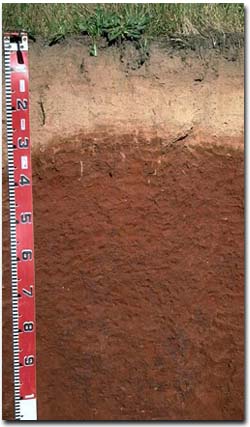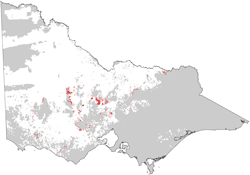Victorian Grain Cropping Soils - Kurosols
Back to: Soils of Victorian Grain Cropping Regions
| Kurosols (Australian Soil Classification) are soils that have strong texture contrast between the surface (A) horizons and the clay subsoil (B) horizons. The subsoil is strongly acid, i.e. pH is 5.4 or less in water, and non-sodic (at least in the upper horizons). |  |
Distribution
| Kurosols are not a major grain cropping soil in Victoria and generally occur in relatively higher rainfall areas (over 600 mm) and in some landscapes that have been extensively weathered. They are most prevalent in the north-central grain cropping region. |  |
Management Considerations
Surface horizons
Management strategies for all soils should include: increasing organic matter levels in the surface soil, minimising the degradation of soil aggregates and porosity, promoting the development of stable biopores, improving the calcium status of the cation exchange complex (particularly when sodium is a significant part), and breaking up any hardpans. Less frequent tillage, using less aggressive implements and working the soil at its optimum moisture content, can all assist in maintaining soil aggregation and porosity, as well as reducing organic matter breakdown.
Organic matter is important for maintaining surface soil aggregations and preventing slaking. Organic matter levels will build up under pasture but will decline if cultivation takes place. Practices such as residue retention, minimum tillage and including pasture rotations can be utilised to build organic matter. The soil surface tends to be hardsetting which is exacerbated through loss of organic matter associated with cultivation, particularly when silt and fine sand contents are high.
In some landscapes, quartz and ironstone gravel content in surface horizons can be significant. This will reduce water availability to shallow-rooted species and provide some restriction to plant roots.
The surface soil of Kurosols is usually naturally strongly acid and consequently aluminium and manganese toxicity may occur. Raising the pH level of the surface soil will help reduce that toxicity. A lime test (sampled at the paddock level) may be appropriate to determine how much lime is needed to raise pH levels. Other factors need to be considered, however, before lime is recommended (e.g. species grown, method of application, local trial responses, likely cost-benefit). Molybdenum deficiency may occur in the strongly acid surface soil and manganese toxicity can also occur, especially when waterlogged. Lime application will make molybdenum more available to plants.
Subsoil horizons
The upper subsoil in Kurosols is strongly acid and exchangeable aluminium levels can be high. Being deeper in the soil profile, this situation is more difficult to ameliorate with lime.
Texture contrast soils usually have restricted root and water movement into the clay rich subsoils. However, Chromosols are non-sodic, at least in the upper subsoil, and tend to be better structured and drained than Sodosols. The upper subsoil is non-sodic and usually well structured, with larger aggregates parting to many fine polyhedral shaped peds. This provides suitable conditions for root and water movement. Reddish colour and lack of mottling in the upper subsoil also indicates that drainage and aeration is good. Waterlogging may still occur after heavy rains, particularly in lower landscape positions.


